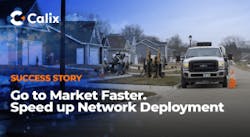Executive Insights With Bob Udell, President and CEO, Consolidated Communications
Topic: Priorities
Sharon Vollman, ISE: What is Consolidated Communications’ vision for what will move the needle in terms of network transformation that will help meet end user’s demands in today’s hyper-connected society?
Bob Udell: Our mission is to turn technology into solutions, enriching how people work and live. We do this by providing broadband solutions to Consumer, Commercial, and Carrier, customers across the communities we serve.
Consolidated Communications is a Top 10 Fiber Provider in the US. We have a deep, fiber network that spans across 23 states with operations centered around 5 core regions in the west, north, south, east, and central.
What really moves the needle is when we can upgrade speeds for our customers, giving them more bandwidth to support typical growth and unforeseen events. In addition, our consultative approach helps businesses move their applications to the cloud by utilizing our Cloud Secure, Cloud Wi-Fi or Unified Communications. Our Carrier customers also need solutions to support wireless densification, which results in more fiber routes deployed to support cell sites and more businesses and homes passed along the way.
Our investments in our fiber network benefit all 3 of our customer groups. For our Consumer customers, fiber technology that supports high-definition TV, uploading high-resolution photos, remote work and learning, video conferencing, and smart home devices is the sweet spot, not to mention being the catalyst for local economic development. In the Commercial space, we are evolving our already robust product portfolio and continue to build on our depth of experience serving vertical industries, such as banking, healthcare, government, and education. And, in the Carrier space, we are adding lit buildings and edging out our network for wireless densification projects and tower upgrades.
InvisiLight® Solution for Deploying Fiber
April 2, 2022Go to Market Faster. Speed up Network Deployment
April 2, 2022Episode 10: Fiber Optic Closure Specs Explained…
April 1, 2022Food for Thought from Our 2022 ICT Visionaries
April 1, 2022Topic: Coronavirus (COVID-19)
ISE: How has the coronavirus (COVID-19) pandemic this year impacted Consolidated?
Bob Udell: COVID-19 has had an extraordinary impact on all of our lives. Now, more than ever, as a nation
we understand the critical importance of connecting consumers, businesses, and carriers, during this time. Our top priority is to protect and keep safe our employees and customers. We’ve implemented numerous preventive measures to ensure their health and safety. In many ways, we’ve changed how we do business, such as virtualizing our call centers, and transitioning our office employees to work from home.
I’m incredibly proud of how proactive our teams have been to anticipate the changes we needed to make and implement them. At this time, we’ve seen an increase in Interent network traffic utilization of approximately 30%, and an increase in voice traffic of approximately 10%, as an impact of the coronavirus (COVID-19). Overall, our network is performing very well and is designed with an architecture that prioritizes video and real time communications, allowing us to handle this increased utilization. We’re here for our customers, and we are continuing to provide them with reliable solutions, including bandwidth upgrades and collaboration tools that are helping them stay connected during this time.
Topic: Pain Points
ISE: Consolidated Communications serves 23 states and approximately 1.2 million connections in underserved and/or rural areas. What are your biggest challenges/obstacles to delivering higher speeds to those customers?
Bob Udell: The biggest challenge is lack of subscriber density, and this isn’t unique to us. It’s a challenge that all service providers of rural America face. Consolidated has an extraordinarily robust fiber network, but in an environment where subscriber density could be much less than one home per square mile, economics can be challenging.
We have the resources to build these networks and, frankly, we are very good at it. We have expanded speeds to more than 750,000 locations across our footprint over the past 2 years. This includes fiber expansion in very rural and geographically challenging locations like Chesterfield, New Hampshire, and across a wide portion of upstate New York.
Despite this challenge, Consolidated remains focused on growing our fiber network and delivering on our promise to provide broadband solutions to rural America.
ISE: In a recent interview, you said that Consolidated is committed to extending its more than 37,500 route miles of fiber. The cities of Portland, Maine; Roseville, California; Conroe, Texas; Champaign, Illinois; Edina, Minnesota; and Fargo, North Dakota; are good examples of communities in which Consolidated has made significant fiber investments. Share a few concrete results from those investments.
Bob Udell: We deploy fiber every day. In 2019, we added more than 600 route miles of fiber to serve all customer types. We serve thousands of cell towers, we help wire municipalities, and we are a leading provider for small and large business customers in all of our 23 states. There’s a lot of synergies among our 3 customer groups. Our past network investments, made for Carrier services, are also benefiting our Commercial customers. We connected 1,800 new buildings onto our network in 2019, an increase of 18%.
We are committed to growing our fiber network and providing access to faster Internet speeds. We do this through our 3-customer strategy: leveraging our network assets to serve Consumer, Commercial, and Carrier customers. Our network is multi-use, meaning when we deploy fiber, we look for opportunities to connect as many customer types as we can. We also continue to pursue public-private partnerships like the one we have with Chesterfield, New Hampshire, with more northern New England municipalities to expand our fiber footprint and bring increased Internet speeds to our customers.
Our next-generation TV service, CCiTV, is available throughout Maine, New Hampshire, and Vermont, and we will expand into new markets this year, which is driving speed upgrades and additional broadband deployment.
Topic: Mixed Network Solutions
ISE:Talk about Consolidated’s strategy to employ a variety of tools and technologies to serve its most rural customers. Given that Consolidated is the carrier of last resort for many of them, how do you make this model work financially? What can the vendors supporting rural providers do to help this?
Bob Udell: We are strong supporters of mixed-use networks. We always look for applications for all 3 of our customer groups — Consumer, Commercial, and Carrier — when deploying and extending our network. That requires that we evaluate a variety of technologies. One example is in rural areas where the economics of deploying fiber to the home may not make economic sense yet, we’re using our fiber-hub architecture to light up fixed wireless services.
Topic: Community Collaboration
In the past, Google struggled to deploy fiber using a long-term, replicative model in their markets of choice. Consolidated works with communities across its 23 states.
ISE: In your opinion, what is the "secret sauce" to making and keeping strong relationships with municipalities as you work to expand your fiber footprint?
Bob Udell: I’d say our approach with municipalities is one based on collaboration and education. We meet frequently with municipalities that want higher broadband speeds. And it’s a different conversation now than it was 2 years ago. Two years ago, the question was What are you going to do to expand broadband? Today, the question is What can we do together? There’s a greater understanding of the economics behind implementing a broadband network. As a result, we’re enlisting the support of a wide range of constituents to help grow the digital economy in rural towns. This includes local leaders, state and federal legislators, and the residents of the towns themselves.
This collaboration and increased level of understanding has helped us be especially successful in our northern New England service area where we have very deep, Middle Mile long-haul fiber networks that can help minimize deployment costs. We’ve seized the opportunity to use that network footprint in conjunction with laws that allow municipalities to fund broadband networks through bond offerings. These public-private partnerships can be transformational to some municipalities where an incumbent carrier may have declined to upgrade its infrastructure, forcing the towns to seek alternatives. We completed the fiber overbuild in Chesterfield, New Hampshire, last year and we have 5 additional overbuild projects targeted for the second half of 2020.
Topic: Public-Private Partnership (P3) Models
ISE: Are P3 models the best way to connect rural America? Why or why not? What are alternative models that might be better?
Bob Udell: We’ve had tremendous success with public-private partnerships, especially in our northern New England service area. State legislators in New Hampshire, for example, have provided the legal mechanism to fund broadband networks. This arrangement for building Last Mile fiber is an ideal fit for us to leverage our very deep Middle Mile, long-haul fiber networks. Used together, the bonding arrangement can help minimize deployment costs while delivering to our customers some of the fastest Internet speeds available.
Our primary focus is on expanding our fiber footprint. Fiber can increase bandwidth a hundredfold, giving customers technology that supports high-definition TV, uploading high-resolution photos, remote work and video conferencing, and smart home devices, not to mention being the catalyst for local economic development.
Topic: Artificial Intelligence
ISE: Artifical Intelligence (AI) across the worldwide telecom market is expected to grow from $235.7 Million in 2016 to reach $2,497.8 Million by 2022, at a CAGR of 46.8% during the forecast period. The increasing adoption of AI for various applications in the telecommunication industry is expected to be driving the growth of the market. (Source: www.marketsandmarkets.com) Why is this critical, and in what areas across the network(s) do you see AI being used in the future (or already today)?
Bob Udell: We have embraced AI as a tool to help us be more efficient, while at the same time making it easier for our customers to do business with us. We currently look at AI as a decision-support tool. We use it to make sure our customers’ calls are routed appropriately to address their needs.
Also, we’re implementing AI and process automation to handle some of the routine types of activities in our frontline, like seasonal line suspensions and restorals. Automation of processes allows us to spend more time developing custom solutions for our customers.
AI is beginning to play a role in network deployment. Looking into the future, I can see a time where AI does even more of the network engineering for our industry, especially on choosing site locations for fiber hubs and wireless antennas.
Topic: Overlooked Issues
ISE: What should all of us in the Information and Communication Technology (ICT) industry be talking about that we are not? Or, what current topic is the most important that needs additional and different attention?
Bob Udell: The industry is very different than it was 20 years ago or even 10 years ago. Some of the regulations put in place were to incentivize competition where monopolies existed. Fast forward 23 years: the industry is highly competitive. We’d like to see all providers operate under the same regulatory requirements. It’s critical for broadband providers to have a level playing field. Whether you are a new entrant or long-time provider who has invested billions, we need to have equitable rules and regulations.
Topic: Smart Smaller Cities
ISE: How can rural providers work with their cities and towns to help them develop comprehensive smart city initiatives? Share your greatest learnings about smart cities and telecom providers’ interconnected relationships and how they need to change in the future.
Bob Udell: Collaboration is key between municipalities and service providers. I’m a big supporter of working with cities to identify innovative solutions that are a win for the town and its citizens. Some towns or municipalities have attempted to build their own broadband network and become their own provider. There are few — if any — examples where this approach has been successful and ends well for the taxpayer who funded it. Partnerships between the town and an experienced service provider allow each to leverage their mutual strengths. We have a number of examples where, in partnership with a town, we’ve built a network and began installing customers in less than 6 months.
ISE: What professional and leadership guidance would you offer a younger Bob as he was forging his career path?
Bob Udell: I’m fortunate to be in a position where I currently mentor a few young professionals on an ongoing basis. The advice I give them is simple: Make this world a better place than you found it. That’s my guiding principle. While simple to state, it can apply to everything.
One should follow their passion and use the energy they get from doing so to motivate those around them to achieve great things. Along the way, listen and learn from the best. Treat others as you like to be treated.
Build a network of trusted advisors. Especially in areas in which you feel weak or unskilled.
When it comes to tough conversations, have them. Do it with respect but with an appropriate tone. The worst feeling is knowing you should have had a conversation and didn’t. Most people respect when they are held accountable, and they benefit from constructive feedback.
Finally, when it comes to making decisions: Do the right thing. Knowing the right thing to do or the right decision to make is a combination of knowledge, experience, and heart or intuition. More often than not, you’ll know the "right thing" to do, and will regret if you don’t do it.
Topic: Your Role
ISE: What is the most interesting thing about your role? What would you recommend to someone who wants to achieve a high-level position in their career?
Bob Udell: The most meaningful aspect of my role is the opportunity to raise the economic prospects for a community by bringing them reliable broadband services which impact their businesses and daily lives. I love seeing our team, employees across 23 states, energized in their roles of delivering service to our customers and prospects.
Topic: Balance
ISE: What do you do to help create work/life balance in your life?
Bob Udell: My view of life balance is built around a conceptual wheel for me. If any one area is too big, it’s not in balance. So, in reality, I’m always working to balance it because life is never perfectly balanced.
My wheel is made up of these spokes: Faith, Family, Work, Health, Community, and Play. Each has meaning to me, which I won’t expand on here, but I can say this: I work to nurture each. Sometimes one needs more attention than the other, but over a period of a week or month, it balances out. I always have something to look forward to, and I make sure of that. I’m blessed with a wonderful family, a team in this business, and good health.
Topic: Mentoring
ISE: What hands-on things should good mentors do?
Bob Udell: I think it’s important to set appropriate examples. As mentors, know your business. Meet with customers frequently and seek input from employees. Make sure accountability is built into your operational processes. Don’t allow "hope" to be anyone’s plan. Instead, show those who you mentor what appropriate inspection points look like, and how to do it in a way that creates a learning opportunity for all involved. Define "success" of any project or plan so you know when to celebrate. And do celebrate successes.
Topic: Satisfaction
ISE: Please fill in the blank: Satisfaction is: __________________________.
Bob Udell: Satisfaction is completing an install of a multi-site turn up and getting a positive acknowledgement from the customer contact that it went well from their perspective.
Satisfaction is also seeing someone you’ve mentored get promoted and celebrated by their colleagues because everyone knows they earned it. This goes for those who move on to other companies too. Sometimes people leave and you still helped them get their chance to impact the world around them. That’s also a reason to celebrate.
Like this Article?
Subscribe to ISE magazine and start receiving your FREE monthly copy today!
Visit ise.mediaquest.co to read even more insights from Bob Udell.
Bob Udell is the President and CEO of Consolidated Communications. Prior to being named President and CEO in 2014, Udell served as the Company’s President and COO, and as SVP upon joining the Company in April 2004.
Udell has more than 25 years of telecommunications leadership experience including profit and loss management and operations at large- and mid-sized local exchange companies. He served in leadership roles at TXU Communications including Executive VP of Business Development, Regulatory and Administration, and COO. He served in leadership roles at McLeodUSA as SVP of Network Services and VP and GM of the company’s Indiana operations, and he held management roles at Bell Atlantic in operations, carrier sales and marketing. For more information, please visit www.consolidated.com.
About the Author
Sharon Vollman
Content Ambassador for ISE EXPO
Sharon Vollman is the Content Ambassador for ISE EXPO. She is passionate about collaborating with thought leaders, SMEs and hard-working doers who design, plan and deploy ultra-reliable broadband networks. Vollman is committed to creating a variety of educational offerings for ISE EXPO attendees that inspire them to connect every U.S. citizen with the broadband networks we all want for our children and grandchildren.
Vollman has created educational partnerships with Broadband Service Providers including AT&T, Verizon, Lumen, Frontier Communications and others. She has covered the telecom industry since 1996.







